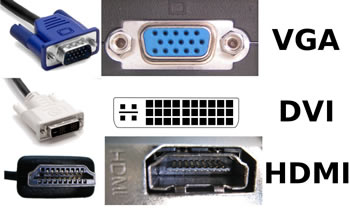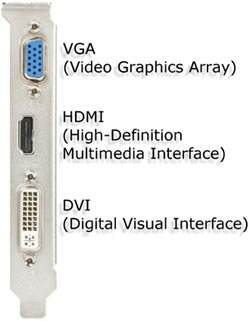Difference between HDMI, VGA and DVI
Key Difference: HDMI, or High-Definition Media Interface, is newest addition to cables that are used to connect video devices to processing units such as CPUs. VGA, or Video Graphics Array, is the oldest cable and is currently the most common video cable that is used to connect the monitors to the CPUs. DVI, or Digital Visual Interface, is somewhat a compromise between the VGA and HDMI.
 The monitor is connected to the CPU using a cord or a wire; it can be any of three wires – HDMI, VGA or DVI. What’s the difference between the three and which one should be opted for when replacing a previous wire? Let’s understand the difference between the three different cords first.
The monitor is connected to the CPU using a cord or a wire; it can be any of three wires – HDMI, VGA or DVI. What’s the difference between the three and which one should be opted for when replacing a previous wire? Let’s understand the difference between the three different cords first.
HDMI, or High-Definition Media Interface, is newest addition to cables that are used to connect video devices to processing units such as CPUs. It was introduced in 2003 and is currently found on almost all modern televisions, they can also be found on PCs – but tend to be a little on the expensive side. HDMI is a digital standard, which basically means that the distance between machine and the monitor or the quality of the cable does not affect the quality of the video. The cable can also handle security and can keep harmful signals from your computer. In addition to video, HDMI can also handle audio with a headphone jack. The port is also significantly smaller than other available cables and has finer but well protected pins, which means no longer having to worry about breaking or bending the pins.
VGA, or Video Graphics Array, is the oldest cable and is currently the most common video cable that is used to connect the monitors to the CPUs. It was introduced in 1987 and is an analog signal, which means that the quality of the cable, the quality of the pins, and the distance of the monitor to the CPU can affect the video quality. VGA only handles video, which means it cannot support audio input. It also has no security features, leaving your computer defenseless against harmful signals. The port is small, but a little wider. It has little screws on the side to tighten the wire. Also, the pins are exposed and can easily be damaged or bent.
 DVI, or Digital Visual Interface, is somewhat similar to both VGA and HDMI. It was invented and introduced in 1999 and is somewhat a compromise between the other two cables mentioned in the article. The cable can be configured for digital, analog, or both and can also handle digital rights management. It can also be converted to both DVI and HDMI using a simple convertor cable or dongle. Most commonly, video cards on computers today come with an HDMI and a DVI connector or can also come with a convertor. Unlike HDMI, DVI does not support audio. It looks similar to VGA in terms of looks, but is wider and larger.
DVI, or Digital Visual Interface, is somewhat similar to both VGA and HDMI. It was invented and introduced in 1999 and is somewhat a compromise between the other two cables mentioned in the article. The cable can be configured for digital, analog, or both and can also handle digital rights management. It can also be converted to both DVI and HDMI using a simple convertor cable or dongle. Most commonly, video cards on computers today come with an HDMI and a DVI connector or can also come with a convertor. Unlike HDMI, DVI does not support audio. It looks similar to VGA in terms of looks, but is wider and larger.
Comparison between HDMI, VGA and DVI:
|
|
HDMI |
VGA |
DVI |
|
Full form |
High-Definition Multimedia Interface |
Video Graphics Array |
Digital Visual Interface |
|
Year of Release |
2002 |
1987 |
1999 |
|
Purpose |
Connect display monitors, video projector, digital television, or digital audio device |
Monitors or TVs but contains video only and not audio |
Computer monitors, television sets, video game consoles and DVD players. |
|
Hot Pluggable |
Yes |
No |
Yes |
|
Number of Pins |
19-29 pins |
15 pins |
29 pins |
|
Compatibility |
Backward compatible with DVI an converters are available |
VGA to DVI and VGA to HDMI converters available |
Can convert to other standards like HDMI and VGAs |
|
Signal |
Digital |
Analog |
Digital and Analog |
Image Courtesy: windowswally.com, community.acer.com









Add new comment